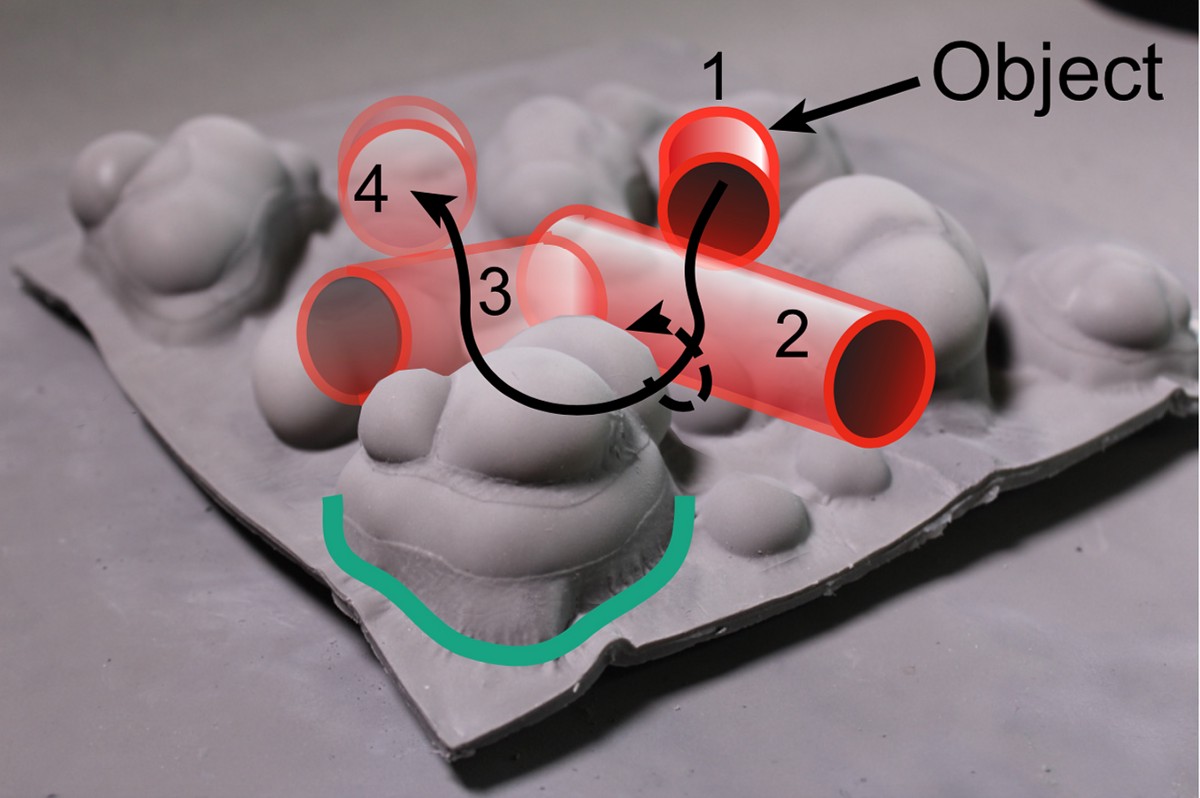
With machines designed to greet customers, reduce stress and care for the elderly, robots are becoming increasingly intertwined with everyday human life. Roboticists today are not only interested in making their designs faster, stronger or more precise, but also in how lifelike, how friendly and how intimately connected to human needs they can be. In recent years, there have been massive advances in the world of “hard” robotics — robots that are made from hard plastics and metals. These robots are excellent for industrial jobs because they are precise, strong and well equipped for strenuous labor. Often, robots are used in these settings as a way to protect humans from potentially dangerous work conditions. It’s a smart solution for factories and warehouses, but what about jobs where humans are more integral to the work itself, such as nursing or healthcare? If researchers could develop robots that interact with humans as carefully as humans interact with one another, they could be used in a variety of fields to improve daily life in radical new ways. This is where soft robotics comes in.

James Pikul, assistant professor in Mechanical Engineering and Applied Mechanics, studies soft robotics, an emerging field that seeks to build robots that can safely handle more delicate and fragile objects. These robots must incorporate materials that deform under pressure, reducing the chances of crushing, pinching or otherwise hurting the equally soft things they interact with, such as human bodies.
In September 2019, Pikul and his team received a $2 million grant from the National Science Foundation to explore a new type of soft robotics that don’t conform to the common conception of robots at all. These soft robots start as flat sheets, then transform into precise shapes to perform tasks. Their goal: to create an inflatable robotic mat to be placed on top of hospital beds and used to move patients. This application has the potential to increase patient comfort and decrease injuries to nurses and healthcare workers that can be caused by patient handling.
To get inspiration for this emerging field, soft robotics engineers often look to nature. Pikul has studied octopuses — an organism with an entirely soft body — and how they transform the texture of their skin to camouflage into their surroundings. He and colleagues from Cornell developed a soft robotic system inspired by this ability; now, he is expanding on this technology. The soft robots Pikul has in mind will go beyond just changing their appearance since they’ll be tasked with safely lifting and moving hospital patients.
Pikul and collaborators at Cornell took inspiration from octopus skin, which changes its texture to mimic rough surfaces, to develop the basis for a new type of soft robot. Pikul and colleagues at Penn are now looking at how such systems could be used to help move patients in healthcare settings. (J. H. Pikul et al. Science 2017)
“The challenge here is that controlling soft materials is very difficult,” Pikul says. “If I build with something soft, how do I control it to make it do something useful? That’s the question we are trying to figure out.”
To answer this question, Pikul and his team had been focusing on understanding the fundamentals of this new approach to soft robotics; healthcare applications were not on their radar right away. Pikul’s team included Penn faculty members Michael Posa, assistant professor in Mechanical Engineering and Applied Mechanics, and Mark Yim, director of the GRASP Laboratory and professor in Mechanical Engineering and Applied Mechanics. Outside of Penn, Ryan Hayward, professor of Chemical and Biological Engineering at the University of Colorado at Boulder and an expert in polymer engineering, joined the group as well as Chris Santangelo, professor of Physics at Syracuse University and an expert in geometry.
But after a conversation with Yim, Pikul met Pam Cacchione, nurse scientist at Penn Presbyterian, Ralston House Term Chair in Gerontological Nursing and associate professor of Geropsychiatric Nursing at Penn. Cacchione and Yim collaborated together on previous robotics projects, and Cacchione had a possible application for Pikul’s soft robotic technology: portable seat lifts for older adults who struggled with getting in and out of chairs. Cacchione has been working with older adults for the majority of her career and her many years of experience as a nurse informed her desire to bring advanced robotic technology into the healthcare world.

Pikul loved the idea and started working with Cacchione to increase the impact of the NSF grant. Together, they took their ideas one step further by adding the portable seat lift design as an initial prototype for the inflatable robotic mat for hospital beds that would assist nurses in moving and turning patients. This intervention would prevent patients from developing pressure injuries and alleviate strain on nurses who are often tasked with moving patients by hand and injuring themselves in the process. Pressure injuries are dangerous, and are caused by prolonged pressure on a part of the body, especially on bony areas such as the heels, ankles, hips, and tailbone. When patients are unable to move themselves, they are put at high risk for developing pressure injuries, creating the need for nurses to reposition patients every few hours. This repeated strain on nurses and healthcare staff can add up to major musculoskeletal injuries that worsen throughout their career.
“Nurses’ injuries are a big problem,” Pikul says. “Many highly qualified nurses are leaving the profession early due to the difficulty of moving patients around. And, as nurses leave the field, the burden is increased for the nurses who remain and the cycle continues.”
A survey conducted by the American Nurses Association found that 56 percent of musculoskeletal pain in nurses was caused or exacerbated by their daily work, 42 percent reported being injured at least once during a 12-month period, and 52 percent reported chronic back pain. Nurses are advised to make use of hospital technologies to reduce strain when moving patients, such as mechanical patient lifts, ceiling mounted lifts and lateral transfer aids. Despite these interventions, Pikul discovered that 12 percent of nurses are leaving the field as a result of patient handling injuries.
“It’s not always one big injury,” says Nina Solis, a nurse in the Hematology and Oncology ward at the Hospital of the University of Pennsylvania and a member of the hospital’s Committee for Safe Patient Handling. “If you’re assisting a patient into a chair and they put their weight on you, you might not get a severe injury from that, but the repeated strain and smaller injuries can compound over time and lead to a major issue.”
“More than that, manually moving a patient is very invasive,” Solis adds. “Often times, complete patients — patients who cannot move themselves at all — aren’t fully aware of why they are being moved. They get anxious and uncomfortable and sometimes people refuse to be moved. I think if there was a technology to move patients more discreetly, the patients themselves would be more relaxed and get more rest.”
Pikul’s technology has the potential increase patient comfort as well. “When you think about it,” Pikul adds, “a hospital bed is already a robot. It bends to different shapes and has sensors to monitor vital signs. They’re already sophisticated systems, they’re just bad at moving people. And we want to fix that.”
Cacchione is excited about the collaboration between Penn Engineering and Penn Nursing and the potential of their joint research.
“It has been really fun working with Penn Engineering, and I’ve enjoyed it very much,” says Cacchione. “There is great synergy between the Schools of Nursing and Engineering because the Nursing school has access to patients and clinical ideas. We are working together to conceptualize engineering ideas and apply them to something that will be meaningful for a patient.”
“This project is about education too.” Pikul says. “Hopefully, the interaction between Nursing and Engineering will give the nurses an appreciation for the capabilities of robotics in modern healthcare, and give roboticists appreciation for the challenges of working with people.”
With his National Science Foundation-funded research, Pikul is laying the groundwork for soft robotics as an innovative field that will help to create the future of robots. Pikul wants to build robots that are safe for close contact with humans and will open up new jobs for robots in everyday life. If he can achieve this, then robots as we understand them will be forever changed as they move from industrial machines on factory floors to intimate technologies involved in all aspects of human health, home and care.
“Safe interaction with robots will be the future of work,” Pikul says. “More and more we are going to be surrounded by and assisted by technology and we want to make sure that we’re doing that in an environment that doesn’t endanger humans. Ultimately, we want people to use these robots so that they make a difference and improves people’s lives.”
